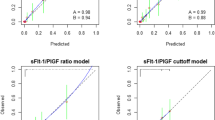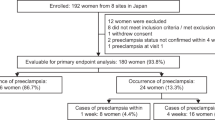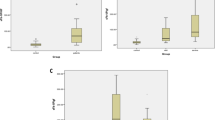Abstract
Purpose
To investigate the accuracy of the soluble fms-like tyrosine kinase-1(sFlt-1)/placental growth factor (PlGF) ratio to predict preeclampsia (PE).
Methods
A search in the PubMed, Embase, and Cochrane Library was conducted for human studies without language restriction. We included the studies reported sufficient data to reconstruct the diagnostic 2 × 2 table of sFlt-1/PlGF with testing of PlGF and sFlt-1 in serum or plasma. Two reviewers independently screened the articles. Disagreements were resolved by a third reviewer. Unpublished data were requested from the authors of the study by email.
Results
Twenty studies with 28 groups of women with different gestational ages were included in our study. The pooled diagnostic sensitivity and specificity of sFlt-1/PlGF were 0.78 and 0.84 with the area under the SROC curve (AUC) of 0.88. In subgroup analyses, the diagnostic value of sFlt-1/PlGF for early-onset PE is highest with a pooled diagnostic odds ratio (DOR) of 241 and AUC of 0.98.
Conclusions
The accuracy of sFlt-1/PlGF ratio for screening PE was moderate and was high for early-onset PE. High-quality studies are needed to confirm their usefulness in prediction of PE in clinical practice.





Similar content being viewed by others
References
Schoofs K, Grittner U, Engels T, Pape J, Denk B, Henrich W, Verlohren S (2014) The importance of repeated measurements of the sFlt-1/PlGF ratio for the prediction of preeclampsia and intrauterine growth restriction. J Perinat Med 42(1):61–68
Mackay AP, Berg C, Atrash H (2001) Pregnancy-Related Mortality From Preeclampsia and Eclampsia. Obstet Gynecol 97(4):533–538
Powe CE, Levine RJ, Karumanchi SA (2011) Preeclampsia, a disease of the maternal endothelium: the role of antiangiogenic factors and implications for later cardiovascular disease. Circulation 123(24):2856–2869. doi:10.1161/CIRCULATIONAHA.109.853127
Kar M (2014) Role of biomarkers in early detection of preeclampsia. J Clin Diagnostic Res 8(4):BE01-BE04
Cerdeira AS, Karumanchi SA (2012) Angiogenic factors in preeclampsia and related disorders. Cold Spring Harbor perspectives in medicine. doi:10.1101/cshperspect.a006585
Rana S, Karumanchi SA, Lindheimer MD (2014) Angiogenic factors in diagnosis, management, and research in preeclampsia. Hypertension 63(2):198–202. doi:10.1161/hypertensionaha.113.02293
Widmer M, Villar J, Benigni A, Conde-Agudelo A, Karumanchi SA, Lindheimer M (2007) Mapping the theories of preeclampsia and the role of angiogenic factors: a systematic review. Obstet Gynecol 109(1):168–180. doi:10.1097/01.AOG.0000249609.04831.7c
Kleinrouweler CE, Wiegerinck MMJ, Ris-Stalpers C, Bossuyt PMM, Van Der Post JAM, Von Dadelszen P, Mol BWJ, Pajkrt E (2012) Accuracy of circulating placental growth factor, vascular endothelial growth factor, soluble fms-like tyrosine kinase 1 and soluble endoglin in the prediction of pre-eclampsia: a systematic review and meta-analysis. BJOG Int J Obstet Gynaecol 119(7):778–787
Moher D, Liberati A, Tetzlaff J, Altman DG (2009) Preferred reporting items for systematic reviews and meta-analyses: the PRISMA statement, vol 339. doi:10.1136/bmj.b2535
Whiting PF, Rutjes AWS, Westwood ME, Mallett S, Deeks JJ, Reitsma JB, Leeflang MMG, Sterne JAC, Bossuyt PMM (2011) QUADAS-2: a revised tool for the quality assessment of diagnostic accuracy studies. Ann Intern Med 155(8):529–536. doi:10.7326/0003-4819-155-8-201110180-00009
Reitsma JB, Glas AS, Rutjes AW, Scholten RJ, Bossuyt PM, Zwinderman AH (2005) Bivariate analysis of sensitivity and specificity produces informative summary measures in diagnostic reviews. J Clin Epidemiol 58(10):982–990. doi:10.1016/j.jclinepi.2005.02.022
Hellmich M, Lehmacher W (2005) A Ruler for interpreting diagnostic test results 44(1):126
Kim SY, Ryu HM, Yang JH, Kim MY, Han JY, Kim JO, Chung JH, Park SY, Lee MH, Kim DJ (2007) Increased sFlt-1 to PlGF ratio in women who subsequently develop preeclampsia. J Korean Med Sci 22(5):873–877
Stepan H, Unversucht A, Wessel N, Faber R (2007) Predictive value of maternal angiogenic factors in second trimester pregnancies with abnormal uterine perfusion. Hypertension 49(4):818–824. doi:10.1161/01.HYP.0000258404.21552.a3
De Vivo A, Baviera G, Giordano D, Todarello G, Corrado F, D’Anna R (2008) Endoglin, PlGF and sFlt-1 as markers for predicting pre-eclampsia. Acta Obstet Gynecol Scand 87(8):837–842. doi:10.1080/00016340802253759
Diab AE, El-Behery MM, Ebrahiem MA, Shehata AE (2008) Angiogenic factors for the prediction of pre-eclampsia in women with abnormal midtrimester uterine artery Doppler velocimetry. Int J Gynaecol Obstet Off Organ Int Fed Gynaecol Obstet 102(2):146–151. doi:10.1016/j.ijgo.2008.02.016
Sibai BM, Koch MA, Freire S, Pinto e Silva JL, Rudge MV, Martins-Costa S, Bartz J, de Barros Santos C, Cecatti JG, Costa R, Ramos JG, Spinnato JA 2nd (2008) Serum inhibin A and angiogenic factor levels in pregnancies with previous preeclampsia and/or chronic hypertension: are they useful markers for prediction of subsequent preeclampsia? Am J Obstet Gynecol 199(3):268.e261–e269. doi:10.1016/j.ajog.2008.06.071
Kusanovic JP, Romero R, Chaiworapongsa T, Erez O, Mittal P, Vaisbuch E, Mazaki-Tovi S, Gotsch F, Edwin SS, Gomez R, Yeo L, Conde-Agudelo A, Hassan SS (2009) A prospective cohort study of the value of maternal plasma concentrations of angiogenic and anti-angiogenic factors in early pregnancy and midtrimester in the identification of patients destined to develop preeclampsia. J Mater-Fetal Neonatal Med Off J Euro Assoc Perinatal Med Fed Asia Oceania Perinatal Soc Int Soc Perinatal Obstet 22(11):1021–1038. doi:10.3109/14767050902994754
Molvarec A, Szarka A, Walentin S, Szucs E, Nagy B, Rigo J Jr (2010) Circulating angiogenic factors determined by electrochemiluminescence immunoassay in relation to the clinical features and laboratory parameters in women with pre-eclampsia. Hypertension research Off J Japan Soc Hypert 33(9):892–898. doi:10.1038/hr.2010.92
Ohkuchi A, Hirashima C, Suzuki H, Takahashi K, Yoshida M, Matsubara S, Suzuki M (2010) Evaluation of a new and automated electrochemiluminescence immunoassay for plasma sFlt-1 and PlGF levels in women with preeclampsia. Hypert Res Off J Japan Soc Hypert 33(5):422–427. doi:10.1038/hr.2010.15
Verlohren S, Galindo A, Schlembach D, Zeisler H, Herraiz I, Moertl MG, Pape J, Dudenhausen JW, Denk B, Stepan H (2010) An automated method for the determination of the sFlt-1/PIGF ratio in the assessment of preeclampsia. American journal of obstetrics and gynecology 202(2):161.e161–161.e111. doi:10.1016/j.ajog.2009.09.016
McElrath TF, Lim KH, Pare E, Rich-Edwards J, Pucci D, Troisi R, Parry S (2012) Longitudinal evaluation of predictive value for preeclampsia of circulating angiogenic factors through pregnancy. American journal of obstetrics and gynecology 207(5):407.e401–407.e407. doi:10.1016/j.ajog.2012.08.010
Chen G, Zhang L, Jin X, Zhou Y, Niu J, Chen J, Gu Y (2013) Effects of angiogenic factors, antagonists, and podocyte injury on development of proteinuria in preeclampsia. Reproductive sciences (Thousand Oaks, Calif) 20(5):579–588. doi:10.1177/1933719112459227
Park HJ, Kim SH, Jung YW, Shim SS, Kim JY, Cho YK, Farina A, Zanello M, Lee KJ, Cha DH (2014) Screening models using multiple markers for early detection of late-onset preeclampsia in low-risk pregnancy. BMC Pregnancy Childbirth 14:35
Lehnen H, Mosblech N, Reineke T, Puchooa A, Menke-Mollers I, Zechner U, Gembruch U (2013) Prenatal clinical assessment of sFlt-1 (Soluble fms-like tyrosine kinase-1)/PlGF (placental growth factor) ratio as a diagnostic tool for preeclampsia, pregnancy-induced hypertension, and proteinuria. Geburtshilfe Frauenheilkd 73(5):440–445
Odibo AO, Rada CC, Cahill AG, Goetzinger KR, Tuuli MG, Odibo L, Macones GA, England SK (2013) First-trimester serum soluble fms-like tyrosine kinase-1, free vascular endothelial growth factor, placental growth factor and uterine artery Doppler in preeclampsia. J Perinatol Off J California Perinatal Assoc 33(9):670–674. doi:10.1038/jp.2013.33
Villa PM, Hamalainen E, Maki A, Raikkonen K, Pesonen AK, Taipale P, Kajantie E, Laivuori H (2013) Vasoactive agents for the prediction of early- and late-onset preeclampsia in a high-risk cohort. BMC Pregnancy Childbirth 13:110. doi:10.1186/1471-2393-13-110
Hanita O, Alia NN, Zaleha AM, Nor Azlin MI (2014) Serum soluble FMS-like tyrosine kinase 1 and placental growth factor concentration as predictors of preeclampsia in high risk pregnant women. Malays J Pathol 36(1):19–26
Doherty A, Carvalho JC, Drewlo S, El-Khuffash A, Downey K, Dodds M, Kingdom J (2014) Altered hemodynamics and hyperuricemia accompany an elevated sFlt-1/PlGF ratio before the onset of early severe preeclampsia. J Obstet Gynaecol Canada JOGC J D’obstetrique et gynecologie du Canada JOGC 36(8):692–700
Moore Simas TA, Crawford SL, Bathgate S, Yan J, Robidoux L, Moore M, Maynard SE (2014) Angiogenic biomarkers for prediction of early preeclampsia onset in high-risk women. J Maternal-Fetal Neonatal Med 27(10):1038–1048
Sunderji S, Gaziano E, Wothe D, Rogers LC, Sibai B, Karumanchi SA, Hodges-Savola C (2010) Automated assays for sVEGF R1 and PlGF as an aid in the diagnosis of preterm preeclampsia: a prospective clinical study. Am J Obstet Gynecol 202(1):40.e41-47. doi:10.1016/j.ajog.2009.07.025
Stubert J, Ullmann S, Bolz M, Kulz T, Dieterich M, Richter DU, Reimer T (2014) Prediction of preeclampsia and induced delivery at <34 weeks gestation by sFLT-1 and PlGF in patients with abnormal midtrimester uterine Doppler velocimetry: a prospective cohort analysis. BMC Pregnancy Childbirth 14(1):292
Levine RJ, Lam C, Qian C, Yu KF, Maynard SE, Sachs BP, Sibai BM, Epstein FH, Romero R, Thadhani R, Karumanchi SA (2006) Soluble endoglin and other circulating antiangiogenic factors in preeclampsia. New England J Med 355(10):992–1005. doi:10.1056/NEJMoa055352
Moore Simas TA, Crawford SL, Solitro MJ, Frost SC, Meyer BA, Maynard SE (2007) Angiogenic factors for the prediction of preeclampsia in high-risk women. Am J Obstet Gynecol 197(3):244.e241–244.e248. doi:10.1016/j.ajog.2007.06.030
Deeks JJ (2001) Systematic reviews in health care: Systematic reviews of evaluations of diagnostic and screening tests. BMJ 323(7305):157–162
Oudejans CB, van Dijk M, Oosterkamp M, Lachmeijer A, Blankenstein MA (2007) Genetics of preeclampsia: paradigm shifts. Hum Genet 120(5):607–612. doi:10.1007/s00439-006-0259-1
Mignini LE, Latthe PM, Villar J, Kilby MD, Carroli G, Khan KS (2005) Mapping the theories of preeclampsia: the role of homocysteine. Obstet Gynecol 105(2):411–425. doi:10.1097/01.AOG.0000151117.52952.b6
James JL, Whitley GS, Cartwright JE (2010) Pre-eclampsia: fitting together the placental, immune and cardiovascular pieces. J Pathol 221(4):363–378. doi:10.1002/path.2719
Levine RJ, Maynard SE, Qian C, Lim KH, England LJ, Yu KF, Schisterman EF, Thadhani R, Sachs BP, Epstein FH, Sibai BM, Sukhatme VP, Karumanchi SA (2004) Circulating angiogenic factors and the risk of preeclampsia. New England J Med 350(7):672–683. doi:10.1056/NEJMoa031884
Karumanchi SA, Lindheimer MD (2008) Preeclampsia pathogenesis: “triple a rating”-autoantibodies and antiangiogenic factors. Hypertension 51(4):991–992. doi:10.1161/HYPERTENSIONAHA.107.100735
Gu Y, Lewis DF, Wang Y (2008) Placental productions and expressions of soluble endoglin, soluble fms-like tyrosine kinase receptor-1, and placental growth factor in normal and preeclamptic pregnancies. J Clin Endocrinol Metabol 93(1):260–266. doi:10.1210/jc.2007-1550
Mutter WP, Karumanchi SA (2008) Molecular mechanisms of preeclampsia. Microvasc Res 75(1):1–8. doi:10.1016/j.mvr.2007.04.009
Acknowledgments
We declare that we have no financial and personal relationships with other people or organizations that can inappropriately influence our work, there is no professional or other personal interest of any nature or kind in any product, service, and/or company that could be construed as influencing the position presented in, or the review of, the manuscript entitled “Diagnostic Accuracy of the Soluble Fms-like Tyrosine Kinase-1/Placental Growth Factor Ratio for Preeclampsia: a Meta-analysis based on 20 Studies.” We have full control of all primary data and we agree to allow the Journal to review our data if requested.
Conflict of interest
The authors declare that they have no conflict of interest.
Author information
Authors and Affiliations
Corresponding authors
Additional information
Y. Liu and Y. Zhao contributed equally to this work.
Rights and permissions
About this article
Cite this article
Liu, Y., Zhao, Y., Yu, A. et al. Diagnostic accuracy of the soluble Fms-like tyrosine kinase-1/placental growth factor ratio for preeclampsia: a meta-analysis based on 20 studies. Arch Gynecol Obstet 292, 507–518 (2015). https://doi.org/10.1007/s00404-015-3671-8
Received:
Accepted:
Published:
Issue Date:
DOI: https://doi.org/10.1007/s00404-015-3671-8




